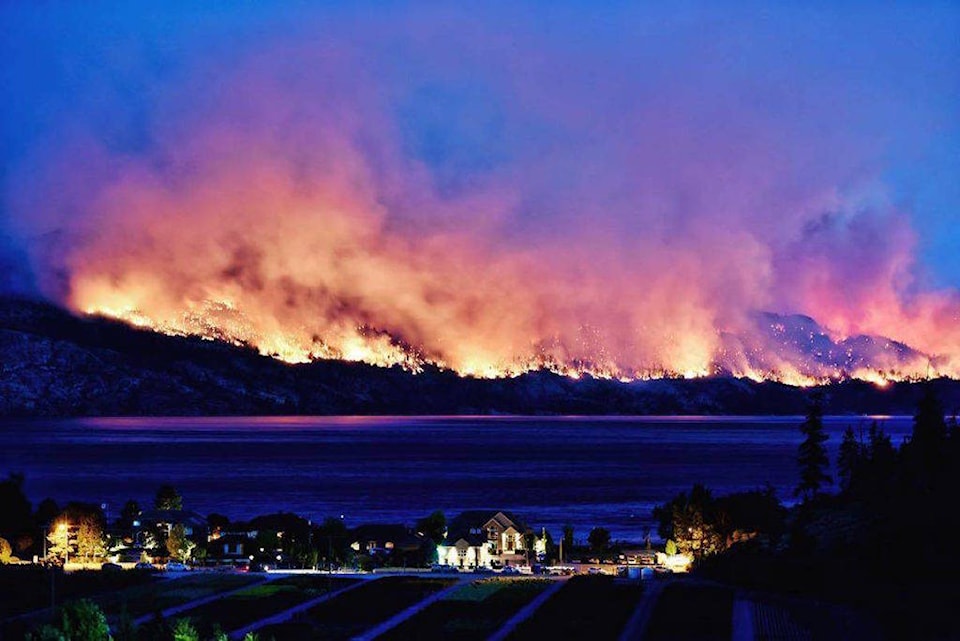A lack of rain in March and April leading to gradual snowmelt has minimized flooding concerns across the Okanagan Valley watershed, according to environment management officials.
But the flip side of that minimal precipitation is the forests are dry, possibly creating a hectic summer ahead for BC Wildfire firefighting efforts.
Shaun Reimer, in charge of the Okanagan Lake Dam water release schedule, said the water release currently is about 30 cubic metres per second, significantly lower than high-water years such as 2017 when the release at this time was 78 cubic metres per second.
“It is much slower this year and based on the latest inflow projections, we are going to be trending down, going from flood potential worry to trying to keep water in the system,” Reimer said, noting Okanagan Lake is currently 30 centimetres below reaching its 342.48-metre full pool target.
But he added the typical rainfall from mid-May to early July in the Okanagan can be a cautionary tale.
“Last year we were 20 centimetres below full pool in Okanagan Lake in April (2020) and then we went substantially over that due to the rain, although we also had a higher snowpack level last year as well,” he said.
Regional approaches to practical water management issues were the focus of several guest speakers at a Zoom forum hosted by the Okanagan Basin Water Board on Wednesday (May 12).
The forum focus was on what to anticipate this year for water management issues related to flooding, fish spawning in regional lakes and tributaries, forest fire risk, weather patterns and lake level monitoring indicators.
READ MORE: Water sustainability plan pitched to Okanagan stakeholders
Dave Campbell, with the BC River Forecast Centre, said snowpack levels have been steadily declining monthly since January, from 132 per cent of normal to 91 per cent in May.
Campbell said snow accumulation has been limited since January, with the mid-elevation snowpack freshet runoff now largely complete.
“The only snow left is at the higher elevation levels above 1,600 metres,” he said.
“Mission Creek is still tracking normal because it is fed by the higher elevation snowmelt, but our Brenda Mines monitoring station is showing the snowmelt done about two weeks earlier than normal. It is a tale of two stories – the mid-level elevation snow is gone, the higher elevation snow is still there.”
“The rainfall patterns will have a significant influence going forward on streamflow conditions for the remainder of the year.”
Doug Lundquist, warning preparedness meteorologist for Environment Canada, said the dryer than normal spring has placed a heightened need for the Okanagan’s May-July rainy season to come through.
“June is the wettest month by far in the Okanagan and we need that to happen again this year. It looks the forecast is for the rains to start up next week so we’ll be watching for that…to help us get through the summer fire season,” Lundquist said.
Bob Warner, with BC Wildfire, said as of May 10, 177 wildfires had burned just over 2,000 hectares across the province.
Warner said it’s still early to read anything into those numbers yet, citing that in historically high fire seasons in 2017 and 2018, there was virtually no fire activity in May for either of those years.
He said forest conditions remain very dry through Kelowna, Penticton, Vernon, Merritt and Salmon Arm.
“The June rains generally dictate the level of wildfire season we will see in July and August. So we keep our fingers crossed we will get some rain in June,” Warner said.
Karilyn Alex, Okanagan Nation Alliance fisheries biologist, says said sockeye salmon, kokanee and rainbow trout spawning numbers remain in line with recent historical markers while the chinook salmon spawning resurgence continues to show positive gains.
Alex said of the 110,000 to 170,000 fish spawning return in the Columbia River system, about 80 per cent find their way back to the Okanagan River, reflecting the historic significance of that salmon run and the need to provide tributary habitat and streamflows to support the revitalization of the fishery.
***
Central Okanagan residents and property owners are invited to share their experience and ideas to help reduce the risks from flooding and high water in a series of upcoming Zoom ‘community conversations.’
The first two forums – May 26, 12-1 p.m.; and May 27, 5:50-6:15 p.m. – address what do you care about regarding flooding in your home community.
The second pair of forums - June 23, 5:15-6:15 p.m., and June 24, 12-1 p.m. – will focus on which flood mitigation options do you want to see in your community.
For more information or to register as a forum participant, visit rdco.com/flood.
